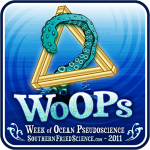 Cryptozoology, the study of animals whose existence is unproven, lies just south of the boundary between science and pseudoscience. Unlike most psuedoscientific movements, which require adherents to suspend disbelief and ignore the realities of physics, chemistry, medicine, and, well, reality, the foundational principals of cryptozoology – that there are remnant populations of thought-to-be-extinct species and that there are still large, charismatic animals that have not yet been discovered – are grounded in ecology. In deep-sea biology, we discover new species all of the time, some of which are far more fantastical than humans can imagine. Some times, we even discover once extinct species. So it is not much of a leap to go from exploratory zoology to cryptozoology.
Cryptozoology, the study of animals whose existence is unproven, lies just south of the boundary between science and pseudoscience. Unlike most psuedoscientific movements, which require adherents to suspend disbelief and ignore the realities of physics, chemistry, medicine, and, well, reality, the foundational principals of cryptozoology – that there are remnant populations of thought-to-be-extinct species and that there are still large, charismatic animals that have not yet been discovered – are grounded in ecology. In deep-sea biology, we discover new species all of the time, some of which are far more fantastical than humans can imagine. Some times, we even discover once extinct species. So it is not much of a leap to go from exploratory zoology to cryptozoology.
Tag: cryptozoology
 Last year for our Week of Ocean Pseudoscience, we counted down our top seven marine cryptids. Number seven was the elusive Steller’s Sea Ape, documented only once by renowned naturalist Georg Wilhelm Steller. Even though the Sea Ape has not been seen since, Steller’s deserved reputation as a world class naturalist has kept the Sea Ape story alive. In his journal, he reports that:
Last year for our Week of Ocean Pseudoscience, we counted down our top seven marine cryptids. Number seven was the elusive Steller’s Sea Ape, documented only once by renowned naturalist Georg Wilhelm Steller. Even though the Sea Ape has not been seen since, Steller’s deserved reputation as a world class naturalist has kept the Sea Ape story alive. In his journal, he reports that:
During this time we were near land or surrounded by it we saw large numbers of hair seals, sea otters, fur seals, sea lions, and porpoises…. On August 10, we saw a very unusual and unknown sea animal, of which I am going to give a brief account since I observed it for two whole hours. It was about two Russian ells in length, the head was like a dog’s, with pointed, erect ears. From the upper and lower lips on both sides whiskers hung down which made it look almost like a Chinaman, The eyes were large; the body was longish round and thick, tapering gradually towards the tail. The skin seemed thickly covered with hair, of a grey color on the back, but reddish white on the belly; in the water, however, the animal appeared equally reddish and cow colored. The tail was divided into two fins, of which the upper, as in the case of sharks, was twice as large as the lower.
Few things have inspired the human imagination quite like the ocean. The vast, mysterious deep is the stuff of poets, artists, explorers, and scientists. A natural result of this seemingly endless, unfathomable world-beneath-the-waves is the emergence of a broad and persistent ocean mythology, ranging from tales of sea monsters, to near magical healing powers, to … Read More “Welcome to a Week of Ocean Pseudoscience!” »